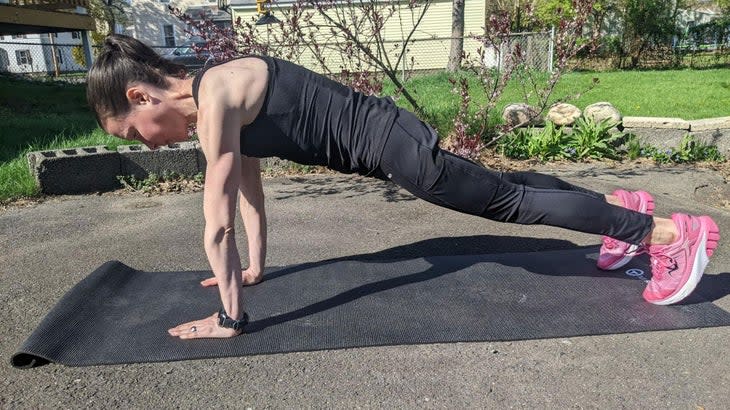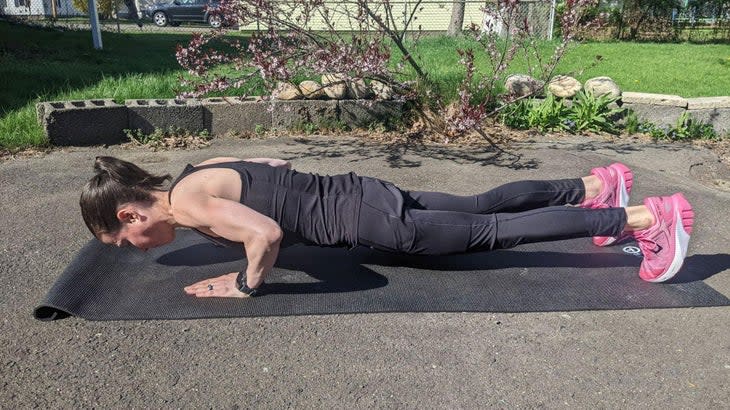The 4 Most Common Mistakes Made While Doing Push-Ups—and How to Fix Them
This article originally appeared on Outside
Whether you love them or dread them, you're likely familiar with the benefits of push-ups. A full-body exercise, push-ups target multiple major muscle groups, including the pectoralis major and minor in your chest, the deltoids in your shoulders, your abdominal and core muscles, your triceps, and the rhomboids and traps in your upper back. Consider the push-up a one-two (three-four-five) punch.
Best of all, push-ups don't require any exercise equipment, making them an ideal movement to include in your at-home workouts. Plus, a 2019 study found that being able to do more push-ups is associated with a lower risk of heart disease.
However, many people struggle with executing push-ups with the proper form and technique. Common mistakes can compromise the effectiveness of the exercise--and potentially increase your risk of injury.
The Most Common Mistakes Made When Doing Push-Ups
The first step in mastering the push-up is to identify the mistakes you're making. Try practicing push-ups in front of a mirror or ask a friend to take a video of your movement so that you see the areas where your form may need work.
1. Using too little range of motion
If you're a beginner when it comes to strength training, you may be unintentionally "cheating" by shortening the range of motion of the exercise. Failing to go deep enough or come into a full extension is one of the most common mistakes with this exercise.
In a proper push-up, you should bend your elbows to at least 90 degrees when you lower your chest down. Your chest should almost touch the floor. On the way up, fully extend your elbows.
If you're struggling to move through the entire range of motion, especially when it comes to lowering your chest, opt for a modified version of the exercise on your knees. You can also practice this exercise with your hands elevated on a table or bench.
2. Placing your hands too far forward
You may be excited to press a few push-ups out--but be wary of placing your hands too far forward. In a proper push-up, you should have your shoulders, elbows, and wrists stacked in a straight line on top of each other. Placing your hands in front of your shoulders can place excessive stress and torque on your shoulders and wrists, as well as reduce the mechanical efficiency of your core muscles to help stabilize your body.
3. Not keeping your hips in line with the rest of your body
Whether you're a total beginner or a seasoned pro, you may be failing to keep your hips in line with the rest of your body.
When you perform a push-up with proper technique, your body should be in a straight line, as if you are a stiff plank or board--from your head down to your heels. Your hips shouldn't sag downward. If your hips do drop, this positioning places excessive stress and strain on your lumbar spine and lower back muscles, disabling you from using your abdominal muscles to brace your core and support your spine.
Additionally, while you may love yoga's Downward-Facing Dog pose, your hips should not be hiked up into the air. This, like sagging hips, means that you're not using your core muscles properly--and missing out on the benefits of push-ups.
4. Flaring your elbows too far out to the sides
One of the most common form and technique mistakes with push-ups is flaring your elbows too far out to the sides when you drop down toward the floor. In doing this, you inadvertently increase the torque or strain on your shoulders and wrists. This flaw often occurs because of a lack of core control or tricep strength.
When you are practicing a push-up, angle your elbows back toward your hip bones. Your shoulders should drop down and meet your hands in the lowered position. Make sure that your hands point forward, rather than in toward one another.
These slight tweaks in form protect your shoulder joints from excessive stress--and help you build strength in your pectoral muscles. When you bend your elbows in toward your waist, instead of out to the side, you're able to target the muscles in your chest.
How to Perform a Push-Up With Proper Form


1. Kneel down and place your hands on the floor with your wrists, elbows, and shoulders stacked in a straight line.
2. Step your feet back in a plank position. Shift your weight onto the toes or balls of your feet.
3. Brace your core and lower your chest toward the ground, bending your elbows until they reach a 90 degree angle.
4. Press through your palms to engage your triceps and pecs. Return to the starting position.
If you need to start with a modified version, that's OK. When you are working on mastering the correct push-up technique, don't be self-conscious or ashamed to start on your knees. By focusing on optimizing your form and range of motion, you'll achieve more long-term success in the effectiveness of this exercise.
For exclusive access to all of our fitness, gear, adventure, and travel stories, plus discounts on trips, events, and gear, sign up for Outside+ today.

